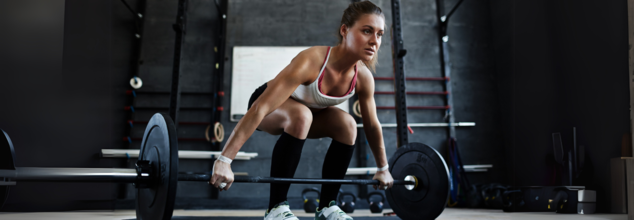
(Credit-Canva)
Explainer: Why Do Heavy Lifters Use Smelling Salts Before Big Lifts?
Videos of heavy lifters often go viral on social media; the sheer power and endurance is not something people can achieve easily. One thing that a lot of them do before they proceed with the lift is smell something and immediately go in for the lift. Those are smelling salts. Smelling salts are products that have a strong ammonia smell and have been used to wake people up after they faint. Lately, some athletes have become interested in using them to feel more alert and perform better. However, do they actually work? Another thing to consider is how something that has such an immediate effect on a person can be safe.
How do Smelling Salts Affect Someone?
According to the National Capital Poison Centre the ammonia that these salts contain has a pungent smell that can cause irritation to the lungs. It can also lead to changes in the breathing patterns. This change in breathing causes people who have fainted to become conscious. These have been present since the 13th century to treat lightheadedness and fainting. The strong odor temporarily increases the heart rate of a person and blood flows to the brain. These symptoms remain for about 15 seconds after inhalation and then subside withing a minute or so. So why do lifters use it when they are fully conscious and do not need to be more alert?
Why Do Gym-Lifters Use Smelling Salts?
Athletes commonly use smelling salts to get a quick boost before or during competitions, hoping it will give them more energy, make them more alert, and speed up their reactions. Unlike many other stimulant drugs, the ammonia in smelling salts is allowed by the World Anti-Doping Agency. You'll often see powerlifters using them, especially right before their final lift, the deadlift. The International Powerlifting Federation even lets athletes inhale ammonia as long as they do it privately. However, even though athletes might feel like smelling salt improves their performance but there is no evidence of it. According to a British Journal of Sports Medicine 2006 article, there's no real proof that they actually make them stronger or more powerful. In the past, smelling salts were sometimes used to treat athletes with minor head injuries, but they probably didn't actually help in those situations.
Smelling Salts Can Go Badly For Anyone
Smelling salts haven't been studied well for use as performance-enhancing supplements, and they aren't approved by the government as stimulant drugs.
The US Food and Drug Association has even warned people about using certain smelling salts that were being advertised to make people more alert and give them energy, even though they hadn't been approved for these uses. They had also received reports of people having problems like shortness of breath, seizures, migraines, vomiting, diarrhea, and fainting after using these products.
National Capital Poison Control provided an example of a female powerlifter who had used smelling salts right before competing. After inhaling, she developed severe symptoms like a runny nose, eye redness, dizziness and a headache. These symptoms got worse over the hour leaving her gasping for air. It was later diagnosed that she was allergic to smelling salts and was treated as such.
Note: If you are thinking about using smelling salts, it's best to talk to a doctor first to see if they are right for you. They can also tell you how often you can use them, if at all, and which products might be best. Keep in mind that smelling salts are not a good idea for everyone. For example, if you have conditions like asthma, allergies, bronchitis, emphysema, or other lung problems, smelling salts might not be safe for you.

(Credit-Canva)
Walking Like This Helps You Burn More Calories!
Walking is one of the best exercises you can do. It engages all your important muscles and helps you burn a lot of calories. It is one of the most accessible forms of exercise that is great for beginners. There are also many ways that you can increase how many calories you burn. One such variation is the Nordic walking. Harvard Health Publishing tells us that Nordic walking is like taking your regular walk and adding a boost with special poles. This exercise was originally created for cross-country skiers to keep up their training during the summer months when there's no snow.
You can say it is similar to cross-country skiing but with no ice and on solid ground! Now, it's become a popular activity for everyone, especially older adults. It's a great way to get moving and get some fresh air, you may think using that the poles people are using is to support themselves, but these poles are meant to mimic the ski poles that boost you on the snow, these poles helps you engage more muscles than just regular walking, turning a simple stroll into a full-body workout. It's easy to learn and can be done almost anywhere.
Why It's Good for You?
Nordic walking is fantastic because it works both your heart and your muscles. It's like getting two workouts in one. Harvard Health Publishing explains that when you walk normally, you mostly use your leg muscles. However, when you add the poles, you start using your arms, shoulders, and core too. This means you're burning more calories, which is great for weight management. It also helps improve your heart health by increasing your heart rate. Plus, it can lower your bad cholesterol and raise your good cholesterol, which is good for your arteries. Nordic walking can also make you feel better mentally by reducing stress and anxiety. Furthermore, because the poles help with balance, you're less likely to fall, which is especially important as you get older.
How Can You Get Started?
To start Nordic walking, you'll need a pair of special poles. These aren't the same as regular hiking poles. Nordic walking poles have a special strap that fits around your wrist like a glove, which helps you push yourself forward. You can find these poles at most sporting goods stores or online. Once you have your poles, you can start practicing the techniques. There are two main techniques: double poling and single poling. Single poling is easier to learn, so it's a good place to start. Just swing one pole at a time, matching the movement of your legs. As you get better, you can try double poling, where you plant both poles at the same time.
The good news is that almost anyone can try Nordic walking. It's a low-impact exercise, which means it's gentle on your joints. Even if you have balance problems, the poles can actually help you feel more stable. However, it's always a good idea to talk to your doctor before starting any new exercise program, especially if you have any health conditions. Once you have your doctor's approval, you can choose a place to walk. You can walk on sidewalks, trails, or in parks. Just make sure the surface is relatively even and safe. You can even join a Nordic walking group, which is a great way to meet new people and stay motivated.

(Credit-Canva)
Sitting For Elongated Hours? Yoga To Relieve Lower Back Pain
Yoga is one of the best ways to ensure your body’s well-being. Whether you are trying to build muscle, increase your flexibility or relieve pain, yoga helps. The stretches and poses in yoga can help you work all your muscles as well as joints. One of the most popular ones are back exercises.
There are many reasons why your back may be hurting. With people spending more hours sitting on desks, whether it is for their jobs, studying etc. When you exercise your back, not only will you strengthen your back muscles, but you will also strengthen your core. Weak core muscles can also contribute to back pain during everyday activities. Medical experts agree that any exercise that strengthens the core is beneficial for lower back pain. While studies suggest yoga isn't significantly superior to other forms of exercise and stretching, it may offer long-lasting pain relief.
Downward-Facing Dog
This classic pose stretches and strengthens almost all muscles, relieving pressure on the spine and easing back tension. Start on hands and knees, lift knees off the floor, and raise your tailbone towards the ceiling, pressing into your hands. For a deeper lower back stretch, bend your knees and lengthen your tailbone upwards.
Child's Pose
Despite appearing restful, Child's Pose effectively stretches the back and hip muscles. It's also a great way to de-stress, especially before bed. Begin on hands and knees, bring big toes together, widen knees, and press hips back towards heels. Walk arms forward, resting forehead on a block, folded arms, or the mat, allowing shoulders to soften.
Reclined Half Pigeon
This variation of Pigeon Pose stretches the hip rotators and flexors. Tight hips can contribute to lower back pain, making this stretch beneficial. Lie on your back with bent knees, cross your left ankle over your right thigh, and thread your left arm through the leg triangle. Hold your right shin or hamstring with both hands, flex both feet, and hug legs towards your body, breathing into hips and lower back.
Triangle Pose
Triangle Pose effectively stretches both the hips and the spine. Facing the long edge of your mat, extend arms to a T and step feet wide. Turn your right toes to the top of the mat and angle your left foot slightly inward. Engage your core as you reach your right arm and torso forward, placing your right hand on the ground or a block outside your right ankle. Extend your left arm straight up, gazing towards your left thumb or straight ahead.
Cat-Cow Pose
Moving between Cat and Cow stretches the back muscles, lengthening and increasing the spine's flexibility. Start on hands and knees, aligning hands under shoulders and knees under hips. Tuck toes for stability and engage your lower abdomen. Inhale, relax your belly down, draw shoulder blades together to open your chest, and lift your gaze into Cow Pose. Exhale, arch your back into Cat Pose, pressing the ground away and tucking your chin to your chest.
Standing Forward Bend
This pose stretches the hamstrings and back muscles. Stand with feet shoulder-width apart and knees loose. Exhale as you hinge at your waist and bend forward, reaching towards the floor. Bending your knees helps lengthen the lower back and deepen the stretch in the legs. Hold for 10 to 20 breaths and repeat as needed.
Low Cobra
Low Cobra helps strengthen the back muscles, promoting healthy lower back alignment and body awareness. Lie on your stomach with forehead on the mat, slide palms back to align thumbs with lowest ribs, and press down through the tops of your feet. Inhale, engage your back body, and curl your chest up, pressing palms into the mat and drawing shoulder blades down and in. Hold for one to five breaths and repeat two to three times.

(Credit-Canva)
Sitting In This Yoga Pose Can Boosts Digestion And Relieve Constipation
Unlike what many people believe, yoga can be easily added into your daily routine and activities. Yoga asanas can be done throughout the day, without making it too overwhelming. For example, doing the mountain pose along with some stretches after you wake up to doing the child pose, followed by cobra pose before bed. Another such yoga pose is Vajrasana, or the thunder or the diamond pose. This is a sitting pose which is not only vital for our posture, but also for digestion.
Doing this yoga pose, after eating for about 10-15 minutes, improves digestion and is a great aid to relieve constipation. This pose is often recommended as a meditational pose or a breathing pose, as it brings about calmness and focus on our body. There are many benefits of Vajrasana.
Benefits of Vajrasana
- Improve concentration
- Reduce feelings of anxiety
- Increase body flexibility
- Lower blood pressure and heart rate
- Help manage symptoms of type 2 diabetes
It's important to remember that yoga should not replace any existing medical treatments, such as medication, unless you have discussed this with a healthcare professional.
How to Perform the Vajrasana Pose
Here is a step by step guide on how to do the Vajrasana pose:
Step 1
Begin by kneeling on the floor. Using a yoga mat can make this more comfortable.
Step 2
Bring your knees and ankles close together, pointing your feet straight back in line with your legs. The soles of your feet should face upward, with your big toes touching.
Step 3
As you exhale, slowly sit back onto your legs. Your buttocks will rest on your heels, and your thighs will rest on your calves.
Step 4
Place your hands on your thighs and gently adjust your pelvis slightly forward or backward until you find a comfortable position.
Step 5
Breathe slowly in and out as you straighten your spine to sit up tall. Imagine the top of your head pulling you upward and gently press your tailbone down towards the floor.
Step 6
Keep your head straight, looking forward with your chin parallel to the floor. Rest your hands on your thighs with your palms facing down and your arms relaxed.
Tips To Make Vajrasana More Comfortable
To make Vajrasana more comfortable or less challenging, several adjustments can be helpful. For those who experience ankle pain, placing a folded blanket or even another cushion under the shin, allowing the toes to extend off the back, can provide relief. If knee pain is an issue, try positioning a rolled or folded blanket or towel across the calves and tucking it behind the knees for added support. Finally, for general sitting discomfort, placing a yoga block horizontally between the feet can help support some of your weight and reduce pressure on both the ankles and knees.
When Should You Avoid Doing Vajrasana?
It's a good idea to talk to your doctor before starting any new yoga program. They can advise you on how yoga might affect your current health and suggest ways to avoid potential problems. It is often recommended that you should not perform Vajrasana if you have knee problems or have recently had surgery or a spinal cord condition, especially involving the lower part of your spine. Another reason why you should avoid this is if you have intestinal ulcers, a hernia, or other intestinal issues.
© 2024 Bennett, Coleman & Company Limited

